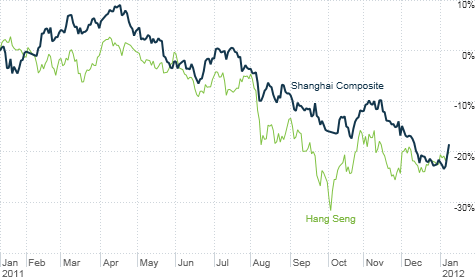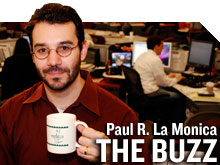Search News

2011 was a brutal year for China's stock market. But the Shanghai Composite has bounced back a bit in 2012. Hong Kong's Hang Seng is following suit.
NEW YORK (CNNMoney) -- The $64,000 question facing the global economy this year should be more accurately dubbed the 404,163 yuan question: Can China avoid a big slowdown in growth in 2012?
Investors, economists and even central bankers are all banking on China to keep expanding at a robust enough pace to ensure that the global economy hums along.

China stocks have gotten off to a strong start following a horrible 2011. The Shanghai Composite plunged more than 20% last year as China's central bank was busy raising interest rates and boosting reserve requirements in order to fight inflation and fears of a housing bubble.
But the Shanghai Composite (SHCOMP) is up about 4% this year, with most of the gains coming in the past few days. Hong Kong's Hang Seng (HSI) has also rebounded so far in 2012.
On Monday, Atlanta Federal Reserve President Dennis Lockhart, a voting member on the Fed's policy committee this year, told reporters following a speech that he was confident in China's ability to engineer a so-called soft landing.
Still, the latest figures regarding China's trade balance have to make you wonder if China really can pull off the proverbial Goldilocks trick (Not too hot. Not too cold. Just right.) with its economy.
While China's trade surplus surprisingly widened in December, much of that was due to a bigger-than-expected slowdown in imports. That's not a good sign. Export growth also slowed a bit, which makes sense given that China's biggest trading partner, Europe, is in a world of sovereign debt hurt.
If Europe gets worse before it gets better, that could be a setback for China. Nonetheless, some experts said that investors should take a step back and look at the big picture.
China probably won't be able to continue reporting annual gross domestic product growth of around 9% to 10%, but it's unlikely to slide into the mid-single digits.
"China is in a more robust position than almost any global economy. Europe is a problem, but I wouldn't anticipate a major slowdown," said Richard Driver, currency analyst with Caxton FX in London. "I still think we are looking to China to lead the global recovery."
It also looks like China realizes that it has an important role in what I've dubbed the Great Global Easing, a coordinated effort by bankers around the globe to prevent Europe from becoming a Lehman-esque disaster.
China has already reversed course on one form of monetary tightening, agreeing to lower reserve requirements for banks at the end of November. That was the first cut since late 2008.
That should allay some fears about a real estate bubble. Ilan Goldfajn, chief economist at Itau BBA in Sao Paulo, Brazil, dismissed concerns that China's housing sector will go bust the way that the U.S. market did a few years ago.
In a China outlook report late last year, Goldfajn wrote that it looks like much of the tightening China did in 2011 is starting to work. Housing prices and sales are slowing, but not yet at an alarming rate.
"Real estate investments are cooling down and there are signs that the sector will decelerate further, though the process is largely induced by the government," he wrote. "In case of a sharp slowdown, with prices falling more than wished for, the government may reverse the process."
And with China due to report its latest inflation figures later this week, there are hopes that pricing pressures -- for food as well as real estate -- have abated enough to allow the People's Bank of China (the Chinese equivalent of the Fed) to finally start lowering interest rates as well.
According to estimates from research firm High Frequency Economics, Chinese consumer prices are expected to have risen at an annual pace of 3.6% in December, compared to 4.2% in November. If inflation does continue to moderate, that's undeniably good news for Chinese consumers and the world.
"While China continues to be affected by uncertainty across the euro zone, we do not anticipate a 'hard-landing' scenario," said Dr. Peter Lee, head of the emerging markets strategy team with Mirae Asset Global Investments in New York. "There have been further indications that inflation in China is on a downward trajectory."
The main issue with China is that investors have to readjust their expectations. Going from, say, 10% growth to 7% growth is not a catastrophe. It's just realistic at a time when many major markets are all facing serious challenges.
Think about it. The U.S. is not healthy, yet it is the best of a sorry bunch compared to Europe and Japan. As long as these economies continue to languish, China is likely to do all it can to make sure that it too doesn't succumb to the malaise plaguing the developed world.
"Policymakers continue to reiterate their support for loosening monetary policy and promoting growth-oriented fiscal measures," Lee said.
Hopefully, he and others who remain bullish on China's prospects are right. The global economy can withstand a mild pullback in China, but it won't be able to hold up if there is a severe contraction.
Best of StockTwits: Yoga apparel maker Lululemon (LULU) isn't in a downward dog position. Shares surged after it lifted guidance Tuesday. And it's just one of several tarnished momentum stocks of 2011 that are making a furious comeback this year.
Lobaeux: Significant upgrade in $LULU guidance, this may foretell other luxury brand's in this barbell economy. $LULU to 65 before pullback?
Not sure I'd go so far to call yoga pants luxury. And for what it's worth, Tiffany (TIF) cut guidance due to somewhat lackluster holiday sales. It cited "restrained spending" for jewelry. I discuss LULU and TIF more in this Buzz video.
CreateCapital: Every once in a while $GS must be right with a public call. Serves to confuse... $LULU.
Yup. To give credit where it's due, The Vampire Squid did add LULU to its "Conviction List" last week. But does that mean a strong sell recommendation is looming next week?
reformedbroker: Just when everyone piled into cardboard companies with dividends - it's the RETURN OF THE RED HOTS! $LULU $NFLX $FOSL $GMCR $MAKO
Heh. It does appear that risk is back in the on position so far in 2012. We'll see how long it lasts. I still like my stodgy dividend companies ...which brings me to this last interesting tidbit.
ivanhoff: The good, old boring railroad stocks near 52-week highs again:
I like seeing that. For one, Union Pacific (UNP, Fortune 500) and Norfolk Southern (NSC, Fortune 500) are solid dividend payers. And even in this app-crazy social media world we live in, you still need good old fashioned 19th century tech to transport stuff such as commodities and consumer goods. Healthy railroads could be good sign for the economy.
The opinions expressed in this commentary are solely those of Paul R. La Monica. Other than Time Warner, the parent of CNNMoney, and Abbott Laboratories, La Monica does not own positions in any individual stocks. ![]()
| Overnight Avg Rate | Latest | Change | Last Week |
|---|---|---|---|
| 30 yr fixed | 3.80% | 3.88% | |
| 15 yr fixed | 3.20% | 3.23% | |
| 5/1 ARM | 3.84% | 3.88% | |
| 30 yr refi | 3.82% | 3.93% | |
| 15 yr refi | 3.20% | 3.23% |
Today's featured rates: